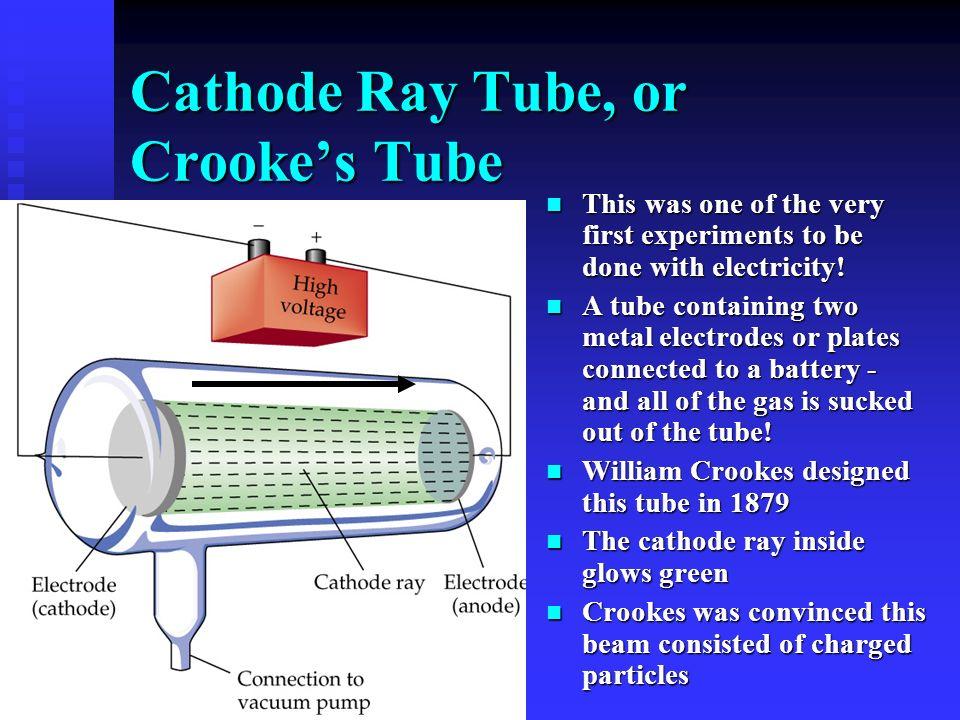

The glow could be moved by a powerful magnet. Second, he found that the glow responded to a magnetic field.

The glow was much brighter than any achieved in previous experiments. First, he was able to produce a bright stream-like glow between the electrodes. Using the improved vacuum tube, Plucker made some startling discoveries. The new vacuum tubes were very popular, and became known as "Geissler's tubes". He constructed a hand-crank mercury pump that could remove most of the air from a tube. Sometime around 1855, Plucker convinced Geissler to design an apparatus for evacuating (completely emptying) a glass tube. Geissler was a skilled glassworker, employed by the University of Bonn ( Germany) as a maker of scientific instruments.

The German team of Heinrich Geissler (1815-1879) and Julius Plucker (1801-1868) pioneered the study of cathode-ray tubes. Faraday was not able to explore this effect completely because technology was not advanced enough to produce a high vacuum within the tube. It was English physician and chemist Michael Faraday (1791-1867) who noticed that as the amount of air in the tube decreased, a faint glow between the electrodes could be seen. When most of the air was evacuated from the tube, an electrical charge could be seen jumping across the gap between the two electrodes. Early ExperimentationĮarly experiments to solve the riddle of electricity often included the use of anode-cathode tubes (glass tubes that contained an anode at one end and a cathode at the other). Great scientists like Henri Becquerel (1820-1891 French chemist and an authority on luminescent, or light caused by radiant energy, phenomena), Marie Curie (1867-1934 Polish-born French physicist who worked extensively with radium) and Thomas Young (1773-1829 English physician and physicist) led the way. Phenomena that had never before been truly understood, such as light, heat, and electricity, were systematically explored. 225-267 (1894).In the mid to late 1800s, the world experienced a scientific revolution. Ueber Kathodenstrahlen in Gasen von atmosphärischem Druck und im äussersten VacuumĪnnalen der Physik und Chemie, Volume 287, pp. Ueber den Durchgang der Kathodenstrahlen durch dünne MetallschichtenĪnnalen der Physik und Chemie, Volume 281, pp. The cathode ray may not be a stream of charged particles but an electromagnetic The cathode ray can penetrate thin films of metals, which suggests that Heinrich Rudolf Hertz and Philipp Eduard Anton von Lenard: Thomson.)Īnnalen der Physik und Chemie, Volume 255, pp. (This conclusion was revised in 1897 by J. Heinrich Rudolf Hertz: The cathode ray does not bend in the electric field. Philosophical Transactions of the Royal Society of London, Volume 170, pp. The bakerian lecture: On the illumination of lines of molecular pressure, and the trajectory of molecules HeĪlso proved it by using his Crookes tube. The cathode, which is the origin of the current of the cathode rays. The following hypothesis Invisible charged particles are ejected from He found dark current without glow under higher vacuum conditions.

William Crookes: A cathode ray = A stream of invisible charged particles Vorläufige Mittheilungen über elektrische Entladungen in verdünnten Gasen, Monatsberichte der Königliche Preussische Akademie der Wissenschaften zu Berlin Aus dem Jhare 1876 Mit 38 Tafeln (Berlin, 1877) pp. > Īnnalen der Physik und Chemie, Volume 212, 197-234 (1869).Įugen Goldstein named the beam "Kathodenstrahlen" (English: "Cathode The vacuum discharge occurred, a shadow was formed on the glass surfaceĪnnalen der Physik und Chemie, Volume 212, 1-31 (1869). When a shield was placed in front of the cathode in the glass tube where Johan Wilhelm Hittorf: Something is coming out of the cathode like a beam. 1824-1914 Johan Wilhelm Hittorf ġ857-1894 Heinrich Rudolf Hertz ġ862-1947 Philipp Eduard Anton von Lenard


 0 kommentar(er)
0 kommentar(er)
